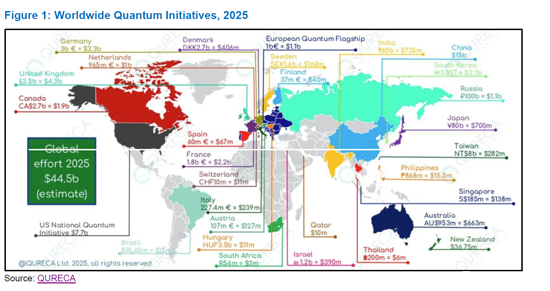|
市場調查報告書
商品編碼
1720934
印度的量子通訊的發展:International Quantum Communication Conclave 2025的考察:政府、學術界和產業界攜手合作,利用量子金鑰分發 (QKD)、光量子通訊 (PQC) 和光子晶片等本土技術,為印度的量子未來鋪路India's Quantum Communication Journey - Insights from the International Quantum Communication Conclave 2025: Government, Academia, and Industry Unite to Drive India's Quantum Future with Indigenous Innovations in QKD, PQC, and Photonic Chips |
|||||||
本報告概述了2025年國際量子通訊高峰會上宣布的戰略舉措、創新和里程碑,並展示了它們如何推動印度面向未來的量子網路建設。
視覺

印度正快速崛起,成為全球量子安全通訊競賽中的關鍵參與者。 2025年舉行的國際量子通訊會議(IQCC)凸顯了印度在該領域日益增強的技術實力。量子通訊(QC)有望成為未來安全網路的核心技術。與傳統密碼學不同,量子通訊利用量子力學定律,對傳統和量子網路威脅均具有很強的抵禦能力。全球量子技術投資已超過445億美元,印度正透過自主研發技術和全國性應用,積極推動策略轉型,確立其在量子技術領域的領導地位。
印度政府已將量子通訊列為其國家量子計畫(NQM)的核心支柱之一,並致力於建立一個強大的生態系統,以支持其研究、商業化和應用。印度理工學院馬德拉斯分校(IIT Madras)、電信發展中心(C-DOT)和拉曼研究所(RRI)等機構正在領導這些基礎計畫。例如,IIT Madras已在欽奈建立了城域量子存取網路(MAQAN)光纖測試平台。 C-DOT 還在新德里的 Sanchar Bhavan 進行了量子金鑰分發 (QKD) 即時實驗,標誌著一項重要的里程碑。此外,印度理工學院德里分校 (IIT Delhi) 和國防研究與發展組織 (DRDO) 已在實驗室環境中成功展示了 50 公里光纖鏈路上的糾纏 QKD,並在現場試驗中演示了 8 公里光纖上的糾纏 QKD。他們還在北方邦的 Prayagraj 和 Vindhyachal(100 公里)之間進行了城際 QKD 通訊試驗。基於這些努力, "本地連接量子互聯網" (QUILA) 計畫旨在透過將地面和衛星 QKD 與後量子密碼 (PQC) 和量子記憶體相結合,建造一個全國性的量子互聯網,透過 2000 公里的量子骨幹網路連接各大城市。
CDOT 作為印度量子商業化的引擎,正在開發基於 COW(相干單向)和 DPS(差分相移)協議的認證 QKD 系統。 CDOT 也正在開發獨立於儀表的量子金鑰分發 (MDI-QKD) 原型,以防止側通道攻擊。 CDOT 的多路復用和多芯光纖 QKD 創新技術還能實現超過 120 公里的安全通訊距離,而無需使用昂貴的暗光纖。 重要的是,CDOT 已實現單光子探測器等關鍵組件的國產化,從而將成本降低了 90%,並顯著減少了對海外來源的依賴。
調查對象
被言及了的組織
|
|
目錄
摘要
簡介
- 量子通訊重要性的理由
IQCC 2025主要的焦點
- 國家當務之急:印度國家量子博物館 (NQM)、印度國家量子技術中心 (CDOT) 和印度理工學院馬德拉斯分校 (IIT Madras) 的作用
- 基礎項目:MAQAN 和 QUILA
- CDOT 的獨特創新
- 小型化與規模化:邁向晶片級量子金鑰分發 (QKD)
- 衛星量子通訊:印度國家科學研究院 (RRI) 和印度太空研究組織 (ISRO) 領先
- QNu 實驗室:從研發到部署
- 量子安全密碼學:已準備好集成
- 全球合作與學習:東芝、IBM、愛立信
所謂印度的量子生態系統重要的理由?
總論:量子通訊的印度的決定性飛躍
This brief outlines the strategic initiatives, innovations, and milestones showcased at the International Quantum Communication Conclave 2025 that are steering India's progress toward future-ready quantum networks.
VISUALS

India is fast emerging as a significant player in the global race toward secure, quantum-based communications. The International Quantum Communication Conclave (IQCC) 2025 spotlighted India's growing capabilities in this field, with quantum communications (QC) poised to become the backbone of future secure networks. Unlike traditional encryption, quantum communication leverages the laws of quantum mechanics, offering resilience against classical and quantum cyber threats. As global investments in quantum technologies exceed $44.5 billion, India is strategically positioning itself to lead with indigenous innovations and national-scale deployments.
The Indian government has made quantum communications a core pillar of its National Quantum Mission (NQM), aiming to create a robust ecosystem of research, commercialization, and deployment. Several institutions such as Indian Institute of Technology (IIT) Madras, the Centre for Development of Telematics (CDOT), and the Raman Research Institute (RRI) are spearheading foundational projects. For example, IIT Madras has pioneered the Metro Area Quantum Access Network (MAQAN) metro fiber testbed in Chennai, while C-DOT's live Quantum Key Distribution (QKD) setup at Sanchar Bhawan, New Delhi marks an important milestone. Separately, IIT Delhi and the Defence Research and Development Organisation (DRDO) have jointly demonstrated entanglement-based QKD over 50 km of fiber link in lab conditions and 8 km of optical fiber in field trials, in addition to executing a 100 km inter-city QKD trial between Prayagraj and Vindhyachal in Uttar Pradesh. Building on these, the ambitious Quantum Internet with Local Access (QUILA) program aims to link major Indian cities through a 2,000 km quantum backbone, integrating terrestrial and satellite QKD with Post-Quantum Cryptography (PQC) and quantum memory, laying the foundation for a national quantum internet.
CDOT, emerging as the country's quantum commercialization engine, has developed certified QKD systems based on Coherent One Way (COW) and Differential Phase Shift (DPS) protocols. CDOT also is prototyping Measurement Device Independent (MDI) QKD for mitigating side-channel attacks. Its innovations in multiplexed and multi-core fiber QKD remove the need for costly dark fiber while extending secure communication ranges to 120+ km. Critically, CDOT has indigenized key components like single-photon detectors, cutting costs by 90% and reducing foreign dependency.
Another major leap forward is the shift toward chip-scale QKD. Miniaturizing bulky quantum components into photonic integrated circuits will allow for scalable, cost-effective deployment across telecom and cloud networks. India is investing heavily in this direction via the Ministry of Electronics and IT (MeitY) and the Department of Science and Technology (DST), funding photonic chip R&D at institutions like Indian Institute of Science (IISc) and IITs. These chips will also form the building blocks for future 6G and AI infrastructure.
Satellite quantum communication is the next frontier. RRI, in collaboration with the Indian Space Research Organization (ISRO), is developing ground-to-satellite QKD systems with adaptive optics and precision tracking, offering a viable solution for long-distance, terrain-agnostic secure links. Their research in device-independent randomness and free-space optics enhances India's readiness for global-scale quantum communication networks.
Finally, industry players like QNu Labs are transitioning research into deployable systems by commercializing hybrid models that integrate QKD, PQC, and quantum random number generators. These efforts, aligned with NQM, mark India's emergence as a serious contender in the global quantum race - strategically, scientifically, and commercially.
Research Coverage
Organizations mentioned:
|
|
Table of Contents
Summary
Introduction
- Why does quantum communications matter?
IQCC 2025 key highlights
- National imperatives: the role of NQM, CDOT, and IIT Madras
- Foundational projects: MAQAN and QUILA
- Indigenous innovation by CDOT
- Miniaturization and scale: Toward chip-scale QKD
- Satellite-Based Quantum Communication: RRI and ISRO lead the charge
- QNu Labs: from R&D to deployment
- Post-Quantum Cryptography: Ready for Integration
- Global alignment and learnings: Toshiba, IBM, and Ericsson
Why India's quantum ecosystem matters?
Conclusion: India's defining leap in quantum communications
List of Figures
- Figure 1: Worldwide Quantum Initiatives, 2025
- Figure 2: Quantum Networks Deployment Projects across India









